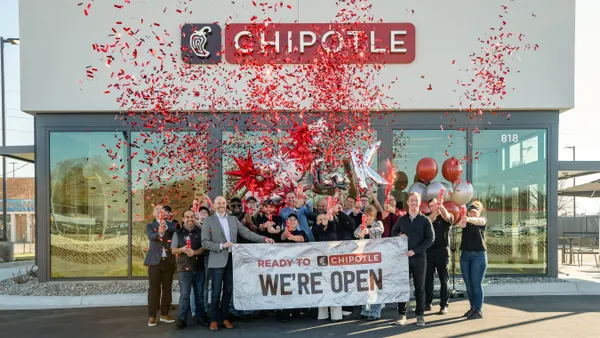UPDATE: April 23, 2020: Domino’s reported a 7.1% increase in same-store sales for its U.S. system for Q2 from March 23 through April 19, according to an earnings release. The company is seeing higher weekday sales while weekend sales are under pressure, Jeff Lawrence, EVP and CFO, said during a Thursday call with investors. Lunch and dinner daypart sales are up, while late night sales are under pressure. The pizza chain has also observed higher orders sizes through the week, he said.
Dive Brief:
- Domino’s estimated same-store sales across its U.S. stores increased 1.6% during the first quarter of the year, with its company-owned stores increasing 3.9% and its franchise stores increasing 1.5%, according to a press release. While its same-store sales started strong at 3.6% during the first month of the year, U.S. same-store sales came in at 1% during the period of Feb. 24 to March 22.
- International sales also started strong with 2.3% same-store sales growth during the first month of the year only to decrease 0.2% during the period of Feb. 24 to March 22. For the quarter, international same-store sales increased 1.5%.
- While a majority of its U.S. stores and supply chain centers remain open, there are currently 14 markets closed and 23 markets with partial closures, representing about 1,400 international stores. France, Spain, New Zealand and Panama make up about 900 of these closures.
Dive Insight:
While Domino’s has yet to break its streak of 36 consecutive quarters of same-store sales growth, its Q1 2020 same-store sales growth is half of what it was during Q1 2019, when U.S. same-store sales increased 3.9%. Demand for pizza has increased in recent weeks and Domino’s is hiring 10,000 employees, but it will still be a rough road ahead as the company grapples with the full impact of the novel coronavirus pandemic.
“Beginning in February and ramping up into March, U.S. sales were impacted by many factors, which have varied in magnitude across the cities and towns we serve. Shelter in place directives, pantry loading, university and school closures, event cancellations, and the lack of live televised sports have all impacted our business in ways that we cannot yet fully quantify,” Ritch Allison, Domino’s CEO, said in the press release.
The company also took a precautionary measure and borrowed the remaining availability of $158 million in its outstanding variable funding notes to improve its strong cash position. Along with its estimated current unrestricted cash, the company has over $300 million on hand to increase its financial flexibility, which will help it stay open and operational.
It’s working on retaining the employees it has and plans to increase pay to its hourly team members and offer enhanced sick leave at its company-owned stores during the crisis. As of Dec. 29, 2019, the company had 342 company-owned stores in the U.S.
Domino's is only offering contactless delivery to customers and had already been working on bulking up its carryout, which grew 8.1% during 2019, and improving delivery times. Allison said during the April 23 conference call with investors it is currently only offering contactless delivery and carryout in the U.S. and he expects these methods to continue to be important for many months to come as the industry evolves. He said that having contactless delivery available will allow the chain to be competitive and to set itself up for what could be the new normal of the industry. To make contactless delivery more seamless, it has made tipping more prominent in the ordering app. It also will be using “pizza pedestals” so that delivery experts don’t place pizzas on the ground or on a surface that could be unclean, Allison said.
With all these measures in place, Domino's may struggle less than many other chains, and the first few weeks of Q2 show that it hasn't dropped off as much sales in the U.S. While it is still struggling to grow sales internationally, markets are starting to reopen. China was the first market to be significantly impacted by COVID-19, Allison said, and sales have started to recover and accelerate during the last few weeks of the quarter.











